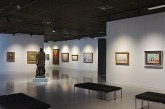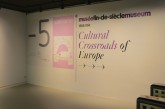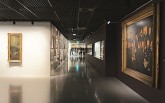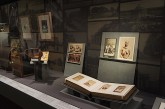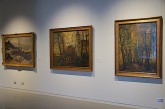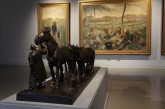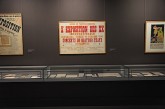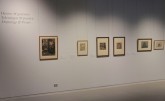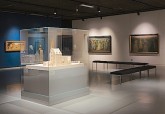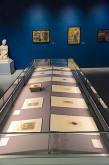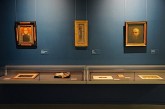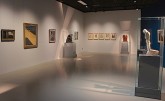The browser will either open the file, download it, or display a dialog.
Musée Fin-de-Siècle Museum
Royal Museums of Fine Arts of Belgium, Brussels
Inauguration on December 6, 2013 (permanent installation)
Catalogue:
Musée Fin-de-Siècle Guide.
Edited by Brigitte de Patoul, with a foreword by Michel Draguet.
Brussels: Éditions Hazan and Musées royaux des Beaux-Arts de Belgique, 2013.
157 pp.; 146 color illus.
€ 15.00 (softcover French, Dutch, and English editions)
ISBN 978-2-7541-0748-8
Nearly two years ago, the Musée Fin-de-Siècle Museum in Brussels opened its doors. Unique in its kind, it shows Brussels to have been the creative crossroads of Europe at the turn of the twentieth century. It is part of the Royal Museums of Fine Arts of Belgium, an institution that reinvented itself by redeploying its federal collections into separate museums, creating the Musée Old Masters Museum, Musée Meunier Museum, Musée Magritte Museum, Musée Wiertz Museum, Musée Modern Museum, and Musée Fin-de-Siècle Museum. Part of the ‘reinvention’ and branding of the Royal Museums is that the museums all carry Musée/Museum in their names to signify their accessibility in both French and English. Each museum has its own brand and its own look and feel.[1] Apart from Musée Meunier and Musée Wiertz, they are all housed in the same building and share the same entrance and ticket sales. A collection as large as that of Belgium’s Royal Museums can be daunting, risking that visitors may be overcome by museum fatigue. With this reorganization, the well-established institution was cleverly brought up to date, making it attractive to today’s audiences with clear cut thematic museums that are easily digestible.
[Belgium] had seen a great artistic upturn around the turn of the century, in some ways even outshining France. Khnopff and Rops in painting, Constantin Meunier and Minne in sculpture, Van der Velde in arts and crafts, Maeterlinck, Eekhoud and Lemonnier in literature set high standards for modern Europe.[2]
The fin-de-siècle period appeals to many, and this ‘yearning for yesterday’ is manifested in many exhibitions.[3] All over Europe, the end of the nineteenth century was experienced as a period of both degeneration and new beginnings. Recent exhibitions include The Magic North: Finnish and Norwegian Art around 1900 at the national galleries of both Oslo and Helsinki, and In the Time of Klimt: The Vienna Secession at the Pinacothèque de Paris.[4] Belgium, too, experienced vertigo years around 1900. In only a few decades, Brussels became a perpetuum mobile with mass mobility and mass communication, quickly bursting at the seams as the masses flocked to the capital.[5] The money that was made by the young Belgian kingdom, thanks to its rule in the Congo, was used to give the capital city a grandiose appearance, Baron Haussmann’s Paris being the source of inspiration.[6]
Musée Fin-de-Siècle
The Musée Fin-de-Siècle exhibits the wealth of Belgian art created between 1868—the year of the foundation of the Société Libre des Beaux-Arts—and the outbreak of the First World War in 1914. The museum aspires to be a Gesamtkunstwerk (total work of art), showing all kinds of artistic disciplines ranging from painting, sculpture, printmaking, architecture, and the decorative arts to literature, music, and opera, as well as new media like photography and cinema. In order to achieve this, the Royal Museums of Fine Arts joined forces with the Royal Library, La Monnaie/De Munt, the Royal Museums of Art and History, Cinematek, Bibliotheca Wittockiana, the King Baudouin Foundation, and the Royal Conservatory of Brussels. To further evoke the spirit of fin-de-siècle Brussels, the museum offers multimedia tools in the form of 3D reconstructions of art nouveau buildings and a visio-guide.
The Musée Fin-de-Siècle presents turn of the century Belgium in all its richness, and Brussels as a metropolis in its own right. Its multi-faceted display is dazzling. The curators have brought together many treasures from all artistic disciplines. For fin-de-siècle devotées—which most of NCAW’s readers undoubtedly are—the Musée Fin-de-Siècle is a feast for the eyes, especially for those with a fondness for works on paper. With its interesting mix of artistic movements and disciplines, the museum really is a ‘total work of art’. This profusion of riches is both its strong point and its pitfall. It is a very complex task to catch the spirit of an era, and then to convey it to the public in a manner that is both attractive and informative. The curators have done an excellent job in displaying the beauty and versatility of Brussels around 1900 to the public. Unfortunately, where the clarification of all this beauty is concerned, the museum has some shortcomings. There is so much for the visitor to digest, and so little readily available explanation, that one is left craving more information.
The museum is completely devoid of explanatory exhibition texts, which is a troubling factor throughout the entire presentation. Here and there, one will find a title on the wall such as “A new vision” or “The fascination of light”— intriguing phrases that make you curious to find out more. The art works themselves have labels with extensive object information, but only a few include a text. These texts are mostly specific to the artwork and therefore insufficient to comprehend the multitude and complexity of the matter at hand. The museum actually offers several sources of information. However, these do not make up for the lack of exhibition texts.
The accompanying catalogue is available in English, French, and Dutch, and has the look and feel of a glossy, high-end magazine (fig. 1). It is richly illustrated, including several double-page spreads, and clearly structured into four sections, each in turn divided into short two-page chapters. Also included are eight short texts that highlight specific subjects that ask for further explanation; for example, the Stoclet House, and the cinema. All in all, it is a very pleasant and readable catalogue. It offers the necessary deepening of understanding, while at the same time remaining attractive for the general public. However, the catalogue is something you buy after your visit.
A visio-guide, which explains key works on a touch screen tablet in sound and image, is available for four euros. But because many people also visit the temporary exhibition, which includes a free audio guide, not many people seem to be willing to hang another guide around their neck. Unfortunately it also has some serious drawbacks. First, the symbol that indicates an artwork is enriched with commentary is very small and often difficult to find. Second, the commentaries are very lengthy and rather academic, and too few objects have one. Third, the videos themselves are of a somewhat trifling quality. Since the museum already offers so much to see in so many different media, they are unnecessary.
It was not until I completed my second visit to the museum that I found out there actually is a little catalogue. On returning my visio-guide, I asked for one of these catalogues. The woman behind the counter rummaged in some cabinets and to her great surprise stumbled upon an unopened box full of little museum guides. This richly illustrated, pocket-sized guide explains complex concepts such as Symbolism and Pictorialism, enhancing one’s understanding of the exhibited works and the story of late nineteenth-century Brussels. Clearly, this lovely guide should be made available to all visitors.
The Musée Fin-de-Siècle is situated in the basement of the Royal Museums. One enters the permanent display of the Musée Fin-de-Siècle on level -5, and from there, one spirals down all the way down to level -8 (fig. 2). The amphitheater-shaped basement is centered around a light shaft, and offers great vistas from one section to the next (fig. 3). It is nonetheless a bit dark; you really sense that you are deep underground. The walls are either white or painted in rich colors such as dark blue, dark grey, or an intense purple. This gives the exhibition rooms a calm appearance, and the tasteful design does not distract attention from the art works. The museum itself is quiet. Although the museum’s concept is to be a Gesamtkunstwerk where all parts are equal, it might be helpful to include a few crowd-pleasers such as James Ensor or Art Nouveau in the museum’s tag line “Cultural Crossroads of Europe” (fig. 4).
The first section of the museum is devoted to Realism. Two paintings stand out in this first exhibition room. Edmond Lambrichs’ painting shows the members of the Société Libre des Beaux-Arts (fig. 5). This artist association was taken as the starting point of the museum, for it was the first to cast off the rules of the traditional academy. At dawn (1875) by Charles Hermans is a great example of Realism (fig. 6). Dawn means something very different to the rich than it does to the poor; as the rich head home after a long night of revelry, the poor are making their way to work.
This first exhibition room is paralleled by one that showcases the influence of France’s Realist masters, Gustave Courbet and Jean-Baptiste-Camille Corot, who took their inspiration from the simplicity of outdoor life exemplified by Corot’s The Heights above Sèvres, Enclosed Pasture (1865–70). The showstopper here is Louis Dubois, who was a strong advocate of Courbet’s Realism; his mysterious Storks (1858) however, is a herald of Symbolism. Especially stunning is Louis Artan’s The Wreck (1871), a virulent seascape that truly evokes the forces of nature (fig. 7).
These two exhibition rooms are connected by a long corridor, the left side of which is fully covered with large reproductions of photographs evoking the urban transformation of Brussels and other Belgian cities in the late nineteenth century (fig. 8). It also serves as a kind of timeline and provides the visitor with a good frame of reference. In four glass cases inset into the right wall of the corridor, the museum highlights photography (fig. 9). This glass case with photographs and old cameras is accompanied by visio-guide commentary. It is very lengthy, containing a general history of photography that is very extensive, and quite complicated, taking too much time and distracting from the museum visit.
Level -6 begins with a section devoted to plein air painting with three gorgeous paintings by Hippolyte Boulenger (fig. 10). It is quickly followed by a larger section on Social Realism. This division is not very clear, and both sections would benefit from at least an explanatory title on the walls. The tasteful ensemble of paintings and sculptures makes the art works related to social realism stand out as complements to each other (fig. 11). Depicting the daily lives of working people, Léon Frederic’s triptych, The Chalk Sellers (1882–83), is an excellent example of Social Realism (fig. 12). Also, the amphitheater-shaped basement with its vistas works well here.
One of the museum’s highlights is the corner devoted to Les XX (The Twenty) and La Libre Esthétique. The museum guide gives an insightful explanation of this artists’ society: Les XX was at the heart of the Belgian avant-garde between 1883 and 1893. The group had a democratic structure and an open, international exhibition policy. Its activities also included lectures on contemporary art and literature, and performances of contemporary music. Les XX was succeeded by La Libre Esthétique, which focused increasingly on the decorative arts and art nouveau. The glass cases show a great variety of works on paper that are both interesting as historical documents, and very appealing because of their beautiful graphic design (fig. 13). The same goes for the exhibition posters. Portraits of Octave Maus, Émile Verhaeren and Edmond Picard by Théo van Rysselberghe and Fernand Khnopff bring to life the people that shaped the Brussels art world at the turn of the century (fig. 14).
Equally stunning is the opposite corner of level -6, which is full of prints and drawings; those by George Lemmen are especially good (fig. 15). A great many of the art works on display are works on paper, especially in the sections on Les XX, printmaking and drawing, and in the corridors. Due to light sensitivity, one hundred of these fragile works are replaced every six months. Not many museums exhibit such a large number of works on paper because it requires renewing the permanent installation so often. The Musée Fin-de-Siècle offers a unique opportunity to enjoy so many prints and drawings. It also means that an extensive part of the museum is renewed twice a year, which makes it worthwhile to visit this ‘permanent’ installation more frequently.
What will appeal to the general public most of all is the large collection of paintings by James Ensor; a wide range of his oeuvre is presented, including masterpieces such as Lamp Boy (1880), Skeletons Fighting Over a Pickled Herring (1891) and The Bad Doctors (1892) (fig. 16). In the section on Impressionism, the rainy or snowy landscapes by Guillaume Vogels stand out (fig. 17). The sombre character of his anecdotal landscapes is alluring. Another strongpoint of the museum’s collection is the selection of Neo-Impressionist paintings. The work of Paul Signac and Georges Seurat was exhibited at the salons of Les XX and La Libre Esthétique, and quickly impacted the Belgian art scene. Seurat, Signac, Théo Van Rysselberghe, and Henry Van de Velde are all represented with excellent works (fig. 18).
Although the range of works by Nabis artists is slight, Edouard Vuillard’s painting, The Two Schoolboys (1894), executed for Alexandre Natanson as one of six decorative panels, is stunning (fig. 19).[7] Bonnard’s Nude Against the Light however, dates from 1908 and is therefore too late for his work as a Nabis. The paintings of Vuillard and Bonnard bring to mind that the museum explicitly showcases Brussels as a European cultural hub. However, practically all art works off non-Belgian artists are French, with the exceptions of Vincent van Gogh, Jan Toorop, Edward Burne-Jones, Alphonse Mucha, and some others. One artist that is clearly missing is Gustav Klimt, who designed decorations for the Stoclet house in Brussels, and who was himself much inspired by Belgian artists such as Fernand Khnopff and George Minne.
Level -7 is devoted to Symbolism, and contains many works by Fernand Khnopff. His painting Memories (Lawn Tennis) forms a great pair with Psyche’s Wedding (1895) by Edward Burne-Jones (fig. 20). A Symbolist painting or drawing by Jan Toorop would make a worthy addition to this section. Nearby, an architectural model of Edouard Pelseneer’s design for the Studio-House of Fernand Khnopff in Brussels draws attention to the importance of architecture as an artistic discipline. The museum specifically explores the relation between Symbolist art and literature with Redon’s print series of Charles Baudelaire’s Fleurs du mal of 1857 (fig. 21). Redon’s original series of drawings for the poetry collection were first exhibited at the Salon des XX in 1890. Also exhibited here is an intriguing portrait of Paul Verlaine by Henry de Groux (fig. 22). The center of Brussels’ Symbolist movement was the Opera house, La Monnaie. It staged many operas by Richard Wagner, and in doing so, introduced the idea of the ‘total work of art’ to the Belgian art scene. An absolute gem is Jean Delescluze’s set design for Wagner’s Parcifal (fig. 23).
Level -8 houses the prestigious Gillion Crowet Collection. Over two hundred art nouveau works by artists such as Émile Gallé, Alphonse Mucha, Louis Majorelle, and Victor Horta have been carefully put together in tasteful arrangements. It testifies to the fin-de-siècle idea that fine arts and decorative arts have an equal status. Not integrating all these decorative art objects into the rest of the museum is a missed opportunity to truly turn the Musée Fin-de-Siècle itself into a Gesamtkunstwerk, as it had aspired to do. As a consequence, the Gillion Crowet Collection is experienced as a museum within the Musée Fin-de-Siècle (itself within the Museums of Fine Arts!). The fact that this collection has its own exhibition design enhances this impression. That being said, the tableaus of furniture and decorative objects with a painting here and there are beautiful. There’s crockery, ceramics and glass objects in abundance—it is a sight for sore eyes (figs. 24, 25). The Gillion Crowet collection is followed by a dozen Idealist paintings. In case you are by now overcome by museum fatigue, Léon Frederic’s triptych, The Stream, will help you to recover from it (fig. 26). This outrageous painting reads like a find-the-hidden-faces puzzle, and is simply great fun.
The final part of the museum is devoted to two of Belgium’s most beloved artists, namely Léon Spilliaert and George Minne. The latter’s sculptures are beautifully combined with Spilliaert’s works on paper, reinforcing each other in perfect harmony (fig. 27). For that reason, this final exhibition room is a definite highlight of the museum. The downside of this beautiful arrangement of Minne’s and Spilliaert’s work is that other early twentieth-century artists are in danger of being overlooked. For example, only one painting by Gustave van de Woestyne is exhibited, and it is squeezed into a little passage behind Minne and Spilliaert (fig. 28). These two artists are considered to have paved ‘the road to modernity,’ as this last section is called. They were the heralds of both expressionism and surrealism.
The story this museum conveys is extraordinarily rich and complex, a clear way of storytelling is therefore an absolute must. The museum would very much benefit from exhibition texts that explain the different sections. They are already at hand in the lovely ‘museum in a nutshell’ guide; all that has to be done is to put them on the walls. That being said, Musée Fin-de-Siècle truly is a treasure trove, and a visit to this museum is much recommended to all NCAW readers visiting Brussels.
Lisa Smit, MA
Art Historian
I am greatly indebted to curator Inga Rossi-Schrimpf for her detailed explanation of Musée Fin-de-Siècle Museum.
[1] The new names were thought up by the communication agency Base Design, and were brought into use in May 2013. See: http://www.brusselnieuws.be/nl/nieuws/museum-voor-schone-kunsten-opgesplitst-brands (May 28, 2015).
[2] Stefan Zweig, Die Welt von Gestern (Berlin: Insel Verlag, [1944] 2014), 147. The English edition is The World of Yesterday (London and New York: Pushkin Press, 2009). The quotation in the original German is “[Belgien] hatte um die Jahrhundertwende einen ungemeinen künstlerischen Aufschwung genommen und sogar in gewissem Sinne Frankreich an Intensität überflügelt. Khnopff, Rops in der Malerei, Constantin Meunier und Minne in der Plastik, van der Velde im Kunstgewerbe, Maeterlinck, Eekhoud, Lemonnier in der Dichtung, gaben ein großartiges Maß der neuen europäischen Kraft.”
[3] Barbara B. Stern, “Historical and Personal Nostalgia in Advertising Text: The Fin de siècle Effect,” Journal of Advertising 21, 4 (1992): 11–22.
[4] Det magiske nord: finsk og norsk kunst omkring 1900 (The Magic North: Finnish and Norwegian Art around 1900), The National Gallery (Nasjonalmuseet), Oslo, Norway (January 30–May 16, 2015) and Ateneum Art Museum, Helsinki, Finland (June 18–September 27, 2015). Au temps de Klimt: La Sécession à Vienne (In the Time of Klimt: The Vienna Secession), The Pinacothèque de Paris, in partnership with Arthemisia Group and 24 ORE Cultura - Gruppo 24 ORE, Paris, France (February 12–June 21, 2015).
[5] Michiel Wagenaar, Stedebouw en burgerlijke vrijheid: de contrasterende carrières van zes Europese hoofdsteden (Urban Development and Civil Freedom: the Contrasting Careers of Six European Capitals) (Bussum: Thoth, 1998), 54–69.
[6] See “1904: His Majesty and Mister Morel” in Philipp Blom, The Vertigo Years: Change and Culture in the West, 1900–1914 (London: Weidenfeld & Nicolson, 2008), chapter 5.
[7] Annette Leduc Beaulieu and Brooks Beaulieu, “Crisis and Resolution in Vuillard’s Search for Art Nouveau Unity in Modern Decoration: Sources for ‘The Public Gardens’,” Nineteenth-Century Art Worldwide 4, no. 2 (Summer 2005): http://www.19thc-artworldwide.org/summer05/crisis-and-resolution-in-vuillards-search-for-art-nouveau-unity-in-modern-decoration-sources-for-the-public-gardens.




